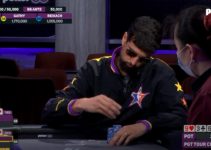Poker tournaments are still hugely popular and have proved to be a very lucrative form of poker for many players.
These winning players aren't using some secret formula, just consistently taking the right approach and making good decisions.
Our 10 tournament poker tips will provide you with the key skills you'll need to take the right winning approach.
For live and online poker, these hot tips will give you a better chance at taking down your next tournament.
Let's dive into the first tip.
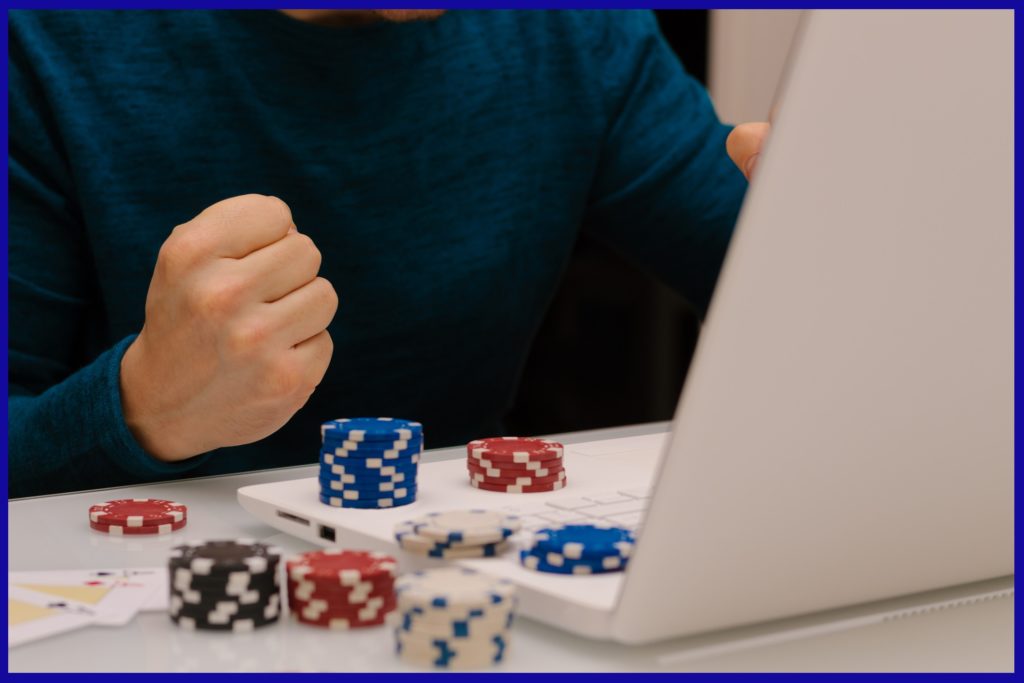
Tip 1: Play The Right Starting Hands
Given the number of preflop charts available these days, it's amazing how many players still enter the pot with all sorts of marginal hands.
It seems to be a testament to the fact that a lot of players just want to gamble and aren't really interested in poker strategy. These players are usually the ones that blame luck for all of their losses. All in all, great news for those reading this article!
Here are the Pokernerve recommended preflop ranges so you never have to guess what hands to play.
♠ Preflop starting hands matrix.
Remember when entering the pot first, enter for a raise and never ever limp with the exception of the small blind position. Leave the limping to the fish.
Position
You'll notice when you look at preflop ranges, you need to play fewer hands the earlier you're seated at the table.
Naturally, if you're in an early position there are more opponents left to act behind you. This increases the likelihood someone could be dealt a really strong hand.
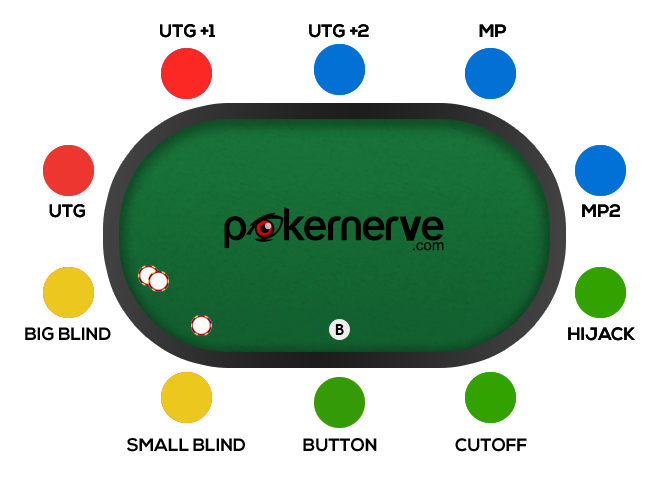
Conversely, this means when you're on the button you can play a fairly wide range. The button is one of the few positions where you can do a considerable amount of calling since you're guaranteed to be in-position.
Don't call a preflop raises with hands like 7♠ 5♠ from middle-position. These hands can look exciting to beginners due to straight and flush possibilities. They're also quite sneaky when they hit big, giving you the feeling of being a ninja.
In reality, over the course of thousands of poker hands, these types of marginal suited connectors will just be costing you a ton of money. They'll struggle post-flop and sometimes you won't even get to see a flop when the pot is re-raised preflop.
Break any preflop bad habits as soon as you can and stick to the preflop range chart.
Finally, note that strategy with these more speculative hands, and play in general, will be altered according to your stack size.
Learn which hands to open raise in MTT's - Watch lesson 6.1 from the Road to Success MTT Course. A power-packed 50 minute video below, just use one of the button options to unlock it and get instant access.
Tip 2: Be Stack Size Aware
The ability to monitor your stack size and adjust your play accordingly is one of the most important tournament poker skills.
Stack sizes at the table can be categorized as either short, medium, or deep. However, this isn't going to be accurate enough for decision-making at the table.
A lot of players use the big blind as an indicator of how deep their stack is. While this isn't a mistake, calculating your stack size according to its 'M' value is optimal.
If you are currently using BB to calculate stack size, here's a look at why using 'M' is a better MTT strategy.
[embedyt] https://www.youtube.com/watch?v=7mWqogp_eKE[/embedyt]Shorter Stacks
Short stacks will be in push-or-fold mode. Being short, they don't have time to wait for good hands and will be looking to take any positive all-in situation that comes up.
Keep in mind this will also mean you won't want to be entering the pot too loosely as the frequency of an all-in will be high when there are multiple short stacks at the table. These all-ins will force you to fold your marginal holdings since you won't be getting the right price to call.
To get you playing as profitably as possible when you're sitting with a short stack, you need to familiarize yourself with power numbers. This simple system will have you playing the short stack like a pro.
Implementing the power number system will massively increase your win rate. Check out the following video to dramatically increase your poker skill with a short stack.
♠ Here's a link for the power number chart.
When it comes to short-to-medium stack play, you need to be careful playing too loosely. Speculative hands won't be getting the implied odds they need to be profitable, so high cards rule.
Deeper stacks
As you get medium-to-deep-stacked, you can start to play more hands, especially when you're on the button.
However, do keep in mind play can be a little trickier to navigate post-flop.
With deeper stacks, they'll typically be multiple streets of play.
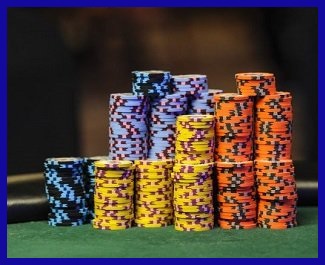
It could be an idea to tighten up a little versus the pros and loosen up versus the fish. As deeper stacks will emphasize any skill advantage that's in play since they'll be more decision points in the hand.
Pivot Points
As you gain experience navigating your stack through the tournament you'll also start to detect certain dynamics at particular stack depths. These are sometimes referred to as pivot points.
An example of this is when aggressive players attack your vulnerable M8-M14 (20bb-35bb) stack with a 3-bet (re-raise).
Why is this stack size vulnerable?
3-bets get good leverage against this stack size, since continuing in the hand represents committing a significant portion of a player's stack.
As we've seen, getting a feel for the table dynamics involves not just monitoring your own stack, but the other players' stacks too. Then you have to keep in mind the player types as well. All part of the challenge of becoming a successful MTT player.
Tip 3: Be Careful Overplaying Hands In The Early Stages
Try not to become one of those players who fall in love with their hand. Remember as stacks get deeper, the less willing a competent player will be to put their entire stack at risk since they have more to lose. It's rare to see good players all-in during the early stages of a big tournament with hands like AK or JJ preflop
Smart players recognize that their opponents aren't going to be risking their entire stack with weaker hands like AQo. Therefore, even a strong hand like AK could be at a significant equity disadvantage facing a deep-stacked opponent's all-in range.
Elect to just call more or sometimes you may need to make some big folds, like the one in the following video. Could you fold QQ here?
[embedyt] https://www.youtube.com/watch?v=btrlIbqCRik[/embedyt]Call More When Deep
Rather than putting in an extra raise, oftentimes just calling with even very strong hands in the early stage of a poker tournament has great benefits.
- Allows your opponents to continue with hands they were folding to a re-raise that you have crushed.
- Disguises the strength of your hand and keeps you unpredictable.
- Prevents you from getting all-in facing a super strong range where often times you're crushed.
These ideas are supported here as we glance over this GTO MTT strategy for UTG+1 vs a BB 3-bet. Notice the calls in green, which include AK and KK.
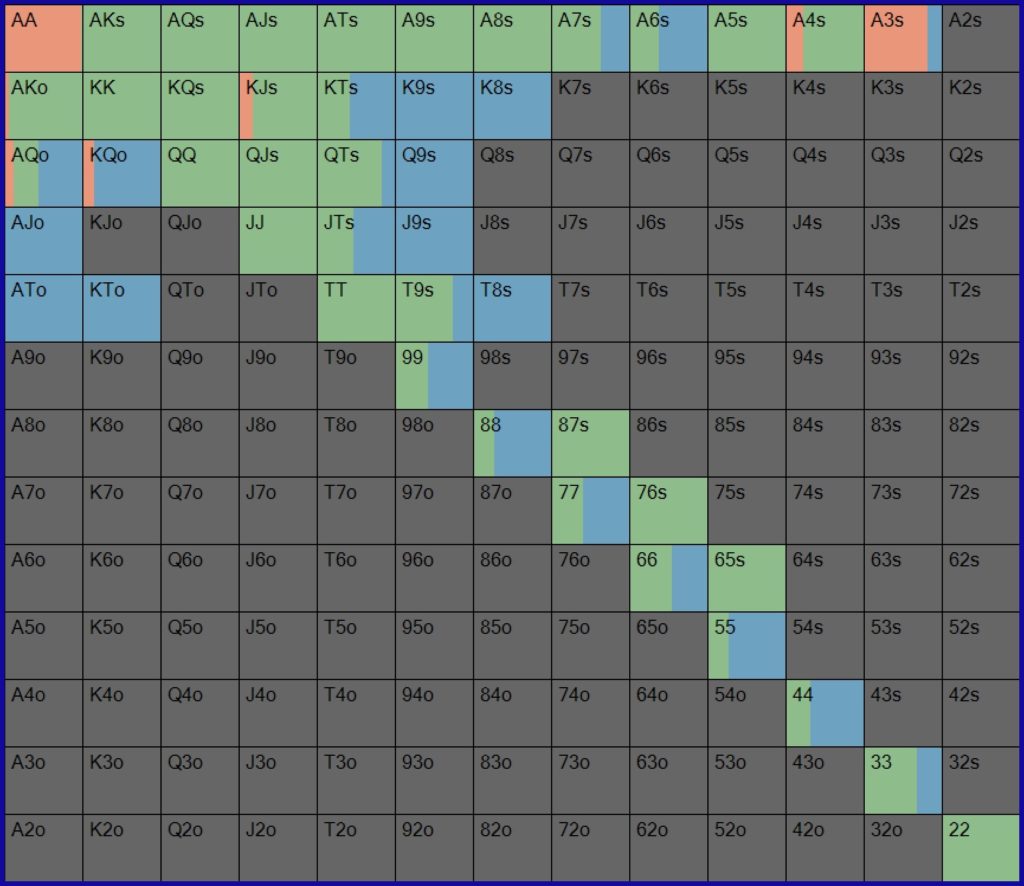
The matrix above shows the GTO MTT strategy for the UTG+1 vs a BB 3-bet @M36 (80bb deep).
On a final note, don't forget it's important to factor in the player type when you have some information on them.
Against some players, we can adjust our range considerably!
Especially at the lower stakes, some villains will be willing to get all-in with all sorts of wild hands. So while we want to be playing good theoretical poker, small, or at times even huge adjustments, are going to be necessary.
Stay observant from the get-go and try to anticipate how you might adjust. This means you'll be ready if you do actually go to war with an opponent!
Flop Texture
Similar to preflop, the same can be said post-flop when it comes to hands that start out strong. A hand such as top pair on the flop might not wind up as a great hand by the river depending on the board run-out.
Consider what sort of hands are possible by the river and the betting pattern of your opponent to try to piece together clues about the strength of their hand.
Being able to make good folds is an important part of MTT poker.
Tip 4: Continuation Bet Aggressively But Not Always
Recreational players have learned the importance of c-betting, but it's a strategy that they often misapply. Being the preflop aggressor shouldn't lead to a mandatory c-bet and double barrels.
When out of position in a SRP (single raised pot), a good basic strategy is to nearly always check. Yet many players just fire a c-bet without considering the flop texture or the fact they are out-of-position.
This also applies to multi-way pots yet players continue to burn money c-betting with weak holdings into multiple opponents.
Key factors to consider include;
- How does the flop texture interact with players' ranges?
- Who has the strongest range on the flop?
- Who has the nut advantage (the biggest share of super strong hands)?
- How passive or aggressive is the opponent we're facing?
- How does the stack size/SPR allow us to operate on the flop and future streets?
The following hand illustrates the effect nut advantage can have on continuation betting.
Tip 5: Learn ICM and Master Final Table Play
When it's the bubble of a tournament or when significant pay jumps loom play alters compared to the earlier stages of a tournament.
Naturally, players want to collect as much as possible from the prize pool. This means shorter stacks will often tighten up hoping other players will bust before them so they can move up the payout ladder.
At the same time, this allows the big stacks to be bullies.
Example
5 of the 6 remaining players at the Pokerstars Sunday Millions have 15bb's, whilst the other player in the UTG position has a tiny 2bb stack. In this case, the 15bb stacks want to avoid busting out next since the short stack may even bust the very next hand and they can move up in the payouts.
Now suppose the action folds to the player in the small blind. What would you do in this spot with 2♥ 6♥?
Actions on you in the small blind with 2♥ 6♥, what's your move?
Mathematically, you could normally move all-in with 57% of hands but given the ICM dynamic, you can now profitably jam 100% of hands!
Pressure opponents at final tables when you can. The small blind should jam any two cards in this spot!
Below is the big blinds reponse to the small blinds 100% all-in range.

We can see from the grids above, the big blinds calling range shrinks from 36% to just 10%. This is simply due to the BB not being able to risk being the next to bust considering the ICM dynamic at the table.
Situations like this come along often when deep in a tourney and present a great opportunity to accumulate chips.
Additionally, some tight players will be giving up too easily on a number of pots, both pre and post-flop. Stay observant and see how much you can get away with.
The Independent Chip Model (ICM) is the best system we have to reflect these sorts of changes in play. There are plenty of ICM calculators out there these days so it's worth playing around with one to get a feel for play when ICM is a factor.
Play for the Win!
Some players get overly carried away with the notion of ICM. Against these types, really step up the aggression and steal a lot of pots from them.
Whilst ICM is important, you still want to gun for that first-place finish.
In flatter pay structures laddering up is often fine but in some larger field MTTs, a first-place finish could be worth 100x what you paid for the tournament entry. So go for gold!

Tip 6: Correct Bet Sizing is a Critical Skill
When you decide you should bet your hand, some important aspects for selecting a size include the following points.
- Which player's range does the board texture favor (range advantage)?
- Who has the greatest proportion of really strong hands (nut advantage)?
- How does SPR influence our betting strategy?
The article How to Find the Right Bet Size Post-flop in 2022 – The 3 Step Guide is a great guide for learning to consistently bet a good size. Other good articles for those wanting more information on bet sizing can be found here - ThePokerBank's article, and Pokerology's article.
One mistake I still see recreational players make is to slow play. Definitely don't try to get tricky with your nutty hands. When you have the goods bet, and bet big! When starting out in tournaments, the rule of never ever slow playing is a good one.
Then there's the other end of the spectrum, bluffing. Bluffing is a major aspect of the game and can be done successfully by following the 3 rules of efficient bluffing.
THE THREE RULES OF EFFICIENT BLUFFING
- Betting will fold out superior holdings
- The combination has some backdoor potential to become strong
- Blocks parts of villains continuing range
All in all, betting is one of the harder aspects of the game and takes a while to master. However, it's an area that many players treat complacently so improving this skill will provide you with a huge edge in your games.
Free MTT Poker Training:
The Underused MTT Skills Essential For Success
- 5 Day Email MTT Poker Training Course By Poker Pro Kelvin "Acesup" Beattie
- 3 Key Skills That Will Take Your MTT Poker Game To A New Level
- 1.5 Hours Of Professional Poker Training

Tip 7: Defend the BB Wide But Not Always (Equity Realization)

Some players defend the big blind with virtually any 2 cards and their justification for this is taking advantage of the excellent pot odds being offered.
While the inclusion of antes combined with commonly seeing a small open raise size does offer the big blind generous pot odds, this has led to a fundamental flaw in the way many players approach big blind play in poker tournaments.
The key concept overlooked, is equity realization.
Equity realization reflects a player's ability to take a certain hand, and win their share of the pot, frequently enough, to make it profitable in the long term. Although some top pros have the ability to win their equity share of the pot even out of position, less skilled players rarely do. This leads to a large chip loss in the long run.
It is quite difficult to realize all of your equity when out of position, with no initiative and a weak range. This means those glorious odds you are being offered aren't quite as good as you think when you're looking down at 9♠ 5♥!
This Equity Realization article explains this crucial tournament poker concept in more detail, .
Tip 8. Try to Avoid Late Registration
The deeper the stacks the more prominent a skill edge is going to be in NLH. So if you think you have an edge over the field, this is the key time to be wielding that edge.
If you doubt you have any edge yet, learning and navigating deep stacks is a key skill to always be working on. So I'd still recommend registering from the start of the tournament.
In particular, you often find a lot of loose cannons in the early stages that don't mind firing a bunch of bullets in re-entry tournaments or just want to gamble it up. Definitely try to target these players and often it will help you build a big stack early.
Whilst registering from the start of the tournament is optimal, that's not to say you can't late register at all. If you're still positive ROI in the tourney during late registration then it's still going to be making you money, so go for it.
Tip 9: Be Aggressive
In tournaments, the big prizes are up top in the final few positions.
You really need to go for it and try to give yourself a chance to make a deep run.
Many pros have had huge success using an aggressive style. Including Jack Sinclair (Pokernerve student), Adrian Mateos, and Bryn Kenney, to name but a few.
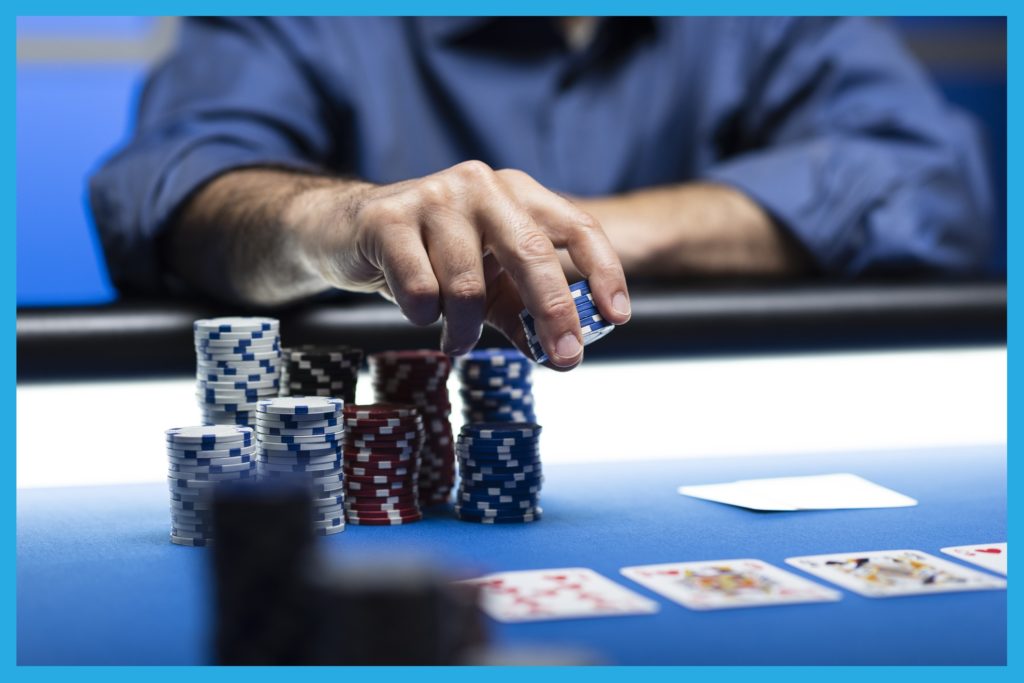
Moreover, consider the fact the general population still plays overly passive which makes the use of aggression an important component for long-term success.
Barrelling Example
'One and done' is the downfall of many aspiring tournament poker players. That is, a simple c-bet then give up if called strategy.
Learn to read the board. Consider how the turn then river cards interact with the ranges in play.
Does the card on the next street favor you or your opponent's range?
Keep in mind the following general pattern when betting street to street.
- Flop: You can bet 2 semi-bluffs for every 1 value hand.
- Turn: Bet 1 semi-bluff for every 1 value hand.
- River: Generally bet 1 bluff for every 2 value hands.
The size you bet will alter the above ratios but it serves well as a general guide.
Player type
The other thing that will affect this ratio is the player type. If you're against a calling station then you can rarely bluff but can bet thinner for value.
At all but the highest stake games, a general population tendency is for players to over-fold the river. So don't hesitate to pull the trigger on the river and fire a bluff. It's all part of a good winning poker strategy.
RedChipPoker has an article on spotting profitable double-barrel opportunities for those interested, called the +EV Double Barrel Guide.
Check-raising example
The most common opportunity to check-raise is in a heads-up pot, after defending the big blind verse an opponent's raise.
Currently, MTT players only check-raise the flop in this situation around 10% of the time, when closer to 20% is a more optimal strategy (obviously depending on the flop texture).
On certain flops, check-raising close to 25% of the time is an extremely profitable strategy. And if players are getting out of line with their c-bets, then check-raising at an even higher frequency could be a great exploit.
By giving up too easily on a wide range of board textures, or taking a more passive approach and simply calling, you're playing into the hands of those who c-bet thoughtlessly.
However, by selecting a nice mix of check-raising hands, combining some strong hands with some good semi-bluffing candidates, a check-raiser can become difficult to play against and exploit the average player's tendency to over c-bet.
Thinking beyond the flop, there are plenty of check-raising opportunities as this video demonstrates!
[embedyt] https://www.youtube.com/watch?v=uFnNGTuy0Vw[/embedyt]Tip 10: Deal with Downswings Like a Professional
You might enter some tournaments after some study, ready to go, with a great mindset. However, things just don't go your way.
All poker players at some point experience downswings. In some cases, this can affect their play, volume, and state of mind.
By understanding variance, it may help to ease any frustration as it's just part of tournament poker.
What is variance and ROI?
Every tournament you enter has an EV associated with it. So if you enter a $10 tourney, as a good player maybe you have a 30% ROI, so you make $3 each entry. Now, of course, you don't make $3 each time. 80-85% of the time you lose that $10, some percentage of the time you win a little bit, and some very small percentage of the time you win a lot. How small those ‘small percentages’ are primarily depends on not only your skill edge but also the field size.
Variance is a factor of two things:
1) Your edge
2) The field size

Example 1
You play the Hot $55 which has $30K guaranteed, every day for a year on Pokerstars. It has 1600 runners and you have a 5% ROI (low because turbo ROIs are small). Your average yearly profit is $605, however, you will lose money on the year 55% of the time due to natural variance!
Example 2
You play a $20 tourney with $3K guaranteed on a softer site every day for a year. It has 200 runners and you have a 30% ROI because it's a normal speed tourney and you’re against an easier field. Your average yearly profit is $2400 and in this case, you have a 12% chance of losing money on the year due to variance.
A lot of people would look at those two tournaments and make a decision based on the buy-in and 1st place prize money as to which was better to play, and it would be grossly wrong. Once you accept all the above, you realize that the 'up top' number isn't so important.
So what can you do?
Decide how important it is to you to win consistently. If you are looking to make money from poker, you'll need to put in a lot of volume and be selective with the tournaments you play.
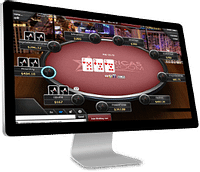
Make sure you're playing a good mix of small field tourneys to ease the variance.
There are plenty of sites to choose from so thankfully it's easy 24/7 to find great games. The best site by a mile is GG Poker with their incredible tournament schedule. ACR and Pokerstars are also good options offering a variety of games.
Finally, if you are experiencing a downswing sometimes just take a break from poker. Or some people find sticking with it but spending more time studying and watching poker videos rather than playing helps keep them fresh.
Bankroll Management
To alleviate the stress of potential downswings it's good to implement some form of bankroll management. Again, this depends entirely on your poker goals.
Some like to have a bankroll strictly for poker and do the associated accounting regularly. Some people are fine just depositing or withdrawing as they please. Work out what works best for you but ideally at least try to monitor your results. There's always software available to help you do this whether you play live or online.
Be prepared for potential downswings by having some solid bankroll management (see TopPokerValue's article on bankroll management for some swing examples).
Tournament Poker Tips Wrap-up
Poker is more fun when you're winning, so start out on the right foot using the profitable starting ranges and implementing our top MTT tips!
For those really keen to propel themselves to the next level, here are a few extra improvement tips to help.
The best ways to accelerate your poker knowledge include hiring a poker coach, doing a poker course, or joining a poker training site. If this is something that interests you be sure to check out the PokerNerve Road to Success Course. It's rated online as the best course for taking beginner-to-intermediate players and helping them master advanced poker tournament strategies.
Here's a glimpse at the over 100 strategy videos in our library!
Alternatively, check out HowToPlayPokerInfo's guide on poker training & poker courses to find the right option for you.
Do you know any other tournament poker tips? Leave them below in the comments, we would love to hear them!




